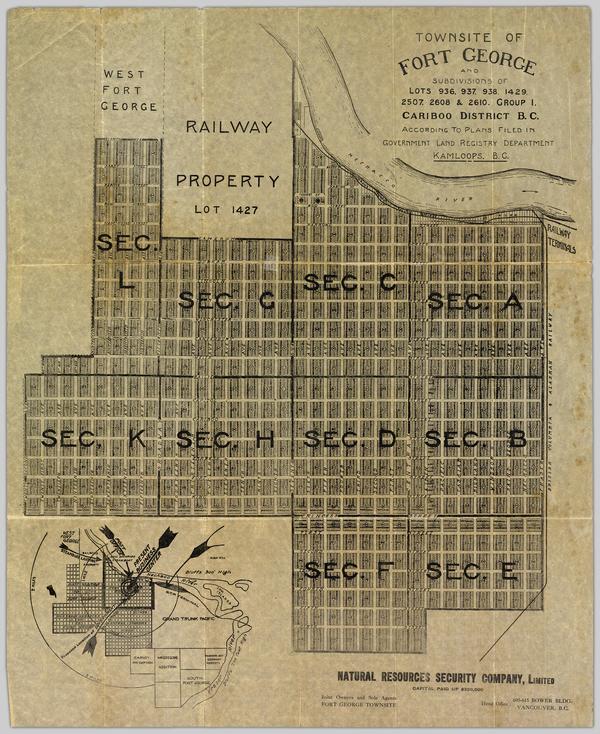Fort George Townsite
Script error: No such module "AfC submission catcheck".
Fort George Townsite was a community in modern day Prince George, British Columbia, Canada. The Fort George Townsite has also been called Fort George and Central Fort George in historical documents and research[1][2].
Fort George was developed by the Natural Resources Security Company and its CEO, George Hammond, as a speculative venture awaiting the arrival of the Grand Trunk Pacific Railroad[1]. It amalgamated into the City of Prince George in 1953.
Location[edit]
The Fort George Townsite was located along adjacent to the Nechako River, North and West of the Hudson's Bay Company trading post on the Fraser river. Construction and development initially began close to the river and moved south into the Central Fort George lots.

Today this area includes the Spruceland area and Spruceland Mall, BX Pub, and Central Avenue. In the modern city the area from around Carney Street westward to Foothills Blvd and from the Nechako River south to near Massy Drive. Carney Street could be considered a boarder line between what was Fort George and the Indian Reserve Lands which would later be developed as Prince George.
History[edit]
in the 1890s, the Grand Trunk Pacific Railway had shown its intentions to build a railway west towards Prince Rupert with the land surrounding the Hudson's Bay Company trading post being a possible area where a railway might pass through[2].

The Fort George Townsite began development in 1909. George Hammond and the NRS bought nine district lots and began development of the area. Lots were initially sold for $400 and later for $500 to $1,000[3].
Advertising and Rivalries[edit]
Fort George competed with South Fort George for people, investment, and paddlewheel service[2]. Hammond's NRS advertised Fort George as the future northern capital, a "Chicago of the North", and exaggerated other claims about the area. The advertisements also preemptively assumed that the GTP railway station would be built in Fort George and thus bolstered lot sales[3][2].
In an effort to have newcomers settle in South Fort George, the South Fort George Herald printed reports claiming that the Fort George Townsite was a roaring construction site, replete with "women in red"[4] The NRS similarly depicted South Fort George as small and insignificant in their advertising campaigns, promoting their own properties[4]
With the development of the City of Prince George by the Grand Trunk Pacific, the Fort George Townsite and South Fort George began to decline as the railroad shifted the business area to the new town.[2]
War years and Depression[edit]
The First world war also diminished the populations of all three townsites with no significant permanent gains until the Second World War.[2] A rebound after the First World War and the ravages of the Spanish Influenza took place as railway work and lumber production increased populations but Prince George would gain the most from this period. The depression in the 1930s saw another reduction in employment and residents, with many single men moving to work or relief camps outside of the city area.[2]

The post First World War period also saw the arrival of air transport and mail delivery. Some using sea planes and others landing on Central Ave until an airfield was developed further south near today's golf course along highway 16.[4] In the Second World War Saw the construction of barracks, drill sheds, training grounds and ranges for military use. Thousands of Canadian and US Armed Forces personnel were stationed in the Prince George area. In Fort George, the modern day gymnastics hall at CN Centre and the Kenroc Building were both originally built by the military as part of a larger camp along 15th ave. The Kenroc building has graffiti made by soldiers stationed there. Range Road in modern day Prince George is so named as the military range was located there, shooting into the hillsides. Approximately 2400 troops were in the camp and additional personnel in the Prince George area and airports[5].
Relations between military on non military were usually good during the Second World War, however there were some tensions due to overcrowding, or to those who had not volunteered for the war[5].
Post war[edit]
The Fort George Townsite did not significantly develop until the post war period when the area was amalgamated into the City of Prince George in 1953.[4] Development of the Spruceland and Heritage area led to further housing construction.
References[edit]
- ↑ 1.0 1.1 Vogt, D. Gamble, D.A. (2010). ""You Don't Suppose the Dominion Government Wants to Cheat the Indians?": The Grand Trunk Pacific Railway and the Fort George Reserve 1908-12". BC Studies. Summer 2010, no 166: 55–77.CS1 maint: Multiple names: authors list (link)
- ↑ 2.0 2.1 2.2 2.3 2.4 2.5 2.6 Leonard, Frank (1984). ""Grand Trunk Pacific and the Establishment of the City of Prince George, 1911-1915"". BC STUDIES. no. 63, Autumn: 29–53.
- ↑ 3.0 3.1 Bumby., Anna (1981). "The Sales Campaign of George J Hammond and the Natural Resources Security Company". CNC.
- ↑ 4.0 4.1 4.2 4.3 Moles, G. Local History in Prince George: A Research Guide. 1986
- ↑ 5.0 5.1 Reimers, Mia "THE GLAMOUR AND THE HORROR: A SOCIAL HISTORY OF WARTIME NORTHWESTERN BRITISH COLUMBIA, 1939 - 1945". THE UNIVERSITY OF NORTHERN BRITISH COLUMBIA, March 1999
This article "Fort George Townsite" is from Wikipedia. The list of its authors can be seen in its historical and/or the page Edithistory:Fort George Townsite. Articles copied from Draft Namespace on Wikipedia could be seen on the Draft Namespace of Wikipedia and not main one.
